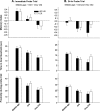Influence of calorie restriction on measures of age-related cognitive decline: role of increased physical activity
- PMID: 19420296
- PMCID: PMC2709546
- DOI: 10.1093/gerona/glp060
Influence of calorie restriction on measures of age-related cognitive decline: role of increased physical activity
Abstract
Controversy exists as to whether lifelong 40% calorie restriction (CR) enhances, has no effect on, or disrupts cognitive function during aging. Here, we report the effects of CR versus ad-lib feeding on cognitive function in male Brown Norway x Fisher344 rats across a range of ages (8-38 months), using two tasks that are differentially sensitive to age-related cognitive decline: object recognition and Morris water maze (MWM). All ages performed equally in object recognition, whereas, as a group, CR rats were impaired. In contrast, there was an age-related impairment in the MWM that was attenuated by CR as measured by time in proximity with and latency to reach the platform. Distance to the platform, a more sensitive measure, was not affected by CR. Finally, CR resulted in an overall increase in physical activity, one of several behavioral confounders to consider in the interpretation of cognitive outcomes in both tasks.
Figures






References
-
- Weindruch R, Walford RL, Fligiel S, Guthrie D. The retardation of aging in mice by dietary restriction: longevity, cancer, immunity and lifetime energy intake. J Nutr. 1986;116:641–654. - PubMed
-
- McCay CM, Crowell MF, Maynard LA. The effect of retarded growth upon the length of life span and upon the ultimate body size. J Nutr. 1935;10:63–79. - PubMed
-
- Mattison JA, Roth GS, Lane MA, Ingram DK. Dietary restriction in aging nonhuman primates. Interdiscip Top Gerontol. 2007;35:137–158. - PubMed
-
- Cadenas E, Davies KJ. Mitochondrial free radical generation, oxidative stress, and aging. Free Radic Biol Med. 2000;29:222–230. - PubMed
-
- Chung HY, Kim HJ, Kim KW, Choi JS, Yu BP. Molecular inflammation hypothesis of aging based on the anti-aging mechanism of calorie restriction. Microsc Res Tech. 2002;59:264–272. - PubMed
Publication types
MeSH terms
Grants and funding
LinkOut - more resources
Full Text Sources
Medical

